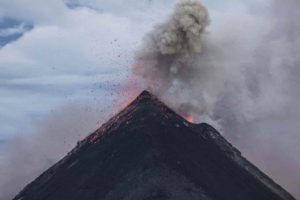
South American volcano showing early warning signs of ‘potential collapse’, research shows
One of South America’s most prominent volcanoes is producing early warning signals of a potential collapse, new research has shown.
Tungurahua volcano in Ecuador — known locally as “The Black Giant” — is displaying the hallmarks of flank instability, which could result in a colossal landslide.
New research, led by Dr James Hickey from the Camborne School of Mines, has suggested that the volcano’s recent activity has led to significant rapid deformation on the western flank.
The researchers believe that the driving force causing this deformation could lead to an increased risk of the flank collapsing, causing widespread damage to the surrounding local area.
The research recommends the volcano should be closely monitored to watch for stronger early warning signs of potential collapse.
The study is published in the journal Earth & Planetary Science Letters.
Dr Hickey, who is based at the University of Exeter’s Penryn Campus, Cornwall, said: “Using satellite data we have observed very rapid deformation of Tungurahua’s west flank, which our research suggests is caused by imbalances between magma being supplied and magma being erupted.”
Tungurahua volcano has a long history of flank collapse, and has also been frequently active since 1999. The activity in 1999 led to the evacuation of 25,000 people from nearby communities.
A previous eruption of Tungurahua, around 3,000 years ago, caused a prior, partial collapse of the west flank of the volcanic cone.
This collapse led to a wide-spread debris avalanche of moving rock, soil, snow and water that covered 80 square kilometres — the equivalent of more than 11,000 football fields.
Since then, the volcano has steadily been rebuilt over time, peaking with a steep-sided cone more than 5000 m in height.
However, the new west flank, above the site of the 3000 year old collapse, has shown repeated signs of rapid deformation while the other flanks remain stable.
The new research has shown that this deformation can be explained by shallow, temporary magma storage beneath the west flank. If this magma supply is continued, the sheer volume can cause stress to accumulate within the volcanic cone — and so promote new instability of the west flank and its potential collapse.
Dr Hickey added: “Magma supply is one of a number of factors that can cause or contribute to volcanic flank instability, so while there is a risk of possible flank collapse, the uncertainty of these natural systems also means it could remain stable. However, it’s definitely one to keep an eye on in the future.”
Reference:
James Hickey, Ryan Lloyd, Juliet Biggs, David Arnold, Patricia Mothes, Cyril Muller. Rapid localized flank inflation and implications for potential slope instability at Tungurahua volcano, Ecuador. Earth and Planetary Science Letters, 2020; 534: 116104 DOI: 10.1016/j.epsl.2020.116104
Note: The above post is reprinted from materials provided by University of Exeter.









